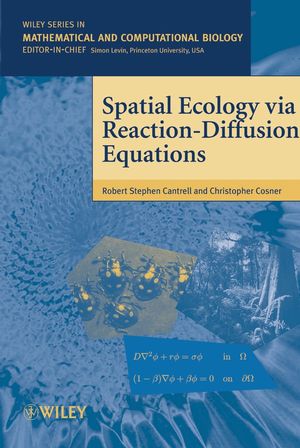Spatial Ecology via Reaction-Diffusion EquationsISBN: 978-0-471-49301-3
Hardcover
432 pages
November 2003
 This is a Print-on-Demand title. It will be printed specifically to fill your order. Please allow an additional 10-15 days delivery time. The book is not returnable.
|
||||||
Preface.
Series Preface.
1 Introduction.
1.1 Introductory Remarks.
1.2 Nonspatial Models for a Single Species.
1.3 Nonspatial Models For Interacting Species.
1.4 Spatial Models: A General Overview.
1.5 Reaction-Diffusion Models.
1.6 Mathematical Background.
2 Linear Growth Models for a Single Species: Averaging Spatial Effects Via Eigenvalues.
2.1 Eigenvalues, Persistence, and Scaling in Simple Models.
2.2 Variational Formulations of Eigenvalues: Accounting for Heterogeneity.
2.3 Effects of Fragmentation and Advection/Taxis in Simple Linear Models.
2.4 Graphical Analysis in One Space Dimension.
2.5 Eigenvalues and Positivity.
2.6 Connections with Other Topics and Models.
Appendix.
3 Density Dependent Single-Species Models.
3.1 The Importance of Equilibria in Single Species Models.
3.2 Equilibria and Stability: Sub- and Supersolutions.
3.3 Equilibria and Scaling: One Space Dimension.
3.4 Continuation and Bifurcation of Equilibria.
3.5 Applications and Properties of Single Species Models.
3.6 More General Single Species Models.
Appendix.
4 Permanence.
4.1 Introduction.
4.2 Definition of Permanence.
4.3 Techniques for Establishing Permanence.
4.4 Invasibility Implies Coexistence.
4.5 Permanence in Reaction-Diffusion Models for Predation.
4.6 Ecological Permanence and Equilibria.
Appendix.
5 Beyond Permanence: More Persistence Theory.
5.1 Introduction.
5.2 Compressivity.
5.3 Practical Persistence.
5.4 Bounding Transient Orbits.
5.5 Persistence in Nonautonomous Systems.
5.6 Conditional Persistence.
5.7 Extinction Results.
Appendix.
6 Spatial Heterogeneity in Reaction-Diffusion Models.
6.1 Introduction.
6.2 Spatial Heterogeneity within the Habitat Patch.
6.3 Edge Mediated Effects.
6.4 Estimates and Consequences.
Appendix.
7 Nonmonotone Systems.
7.1 Introduction.
7.2 Predator Mediated Coexistence.
7.3 Three Species Competition.
7.4 Three Trophic Level Models.
Appendix.
References.
Index.
Series Preface.
1 Introduction.
1.1 Introductory Remarks.
1.2 Nonspatial Models for a Single Species.
1.3 Nonspatial Models For Interacting Species.
1.4 Spatial Models: A General Overview.
1.5 Reaction-Diffusion Models.
1.6 Mathematical Background.
2 Linear Growth Models for a Single Species: Averaging Spatial Effects Via Eigenvalues.
2.1 Eigenvalues, Persistence, and Scaling in Simple Models.
2.2 Variational Formulations of Eigenvalues: Accounting for Heterogeneity.
2.3 Effects of Fragmentation and Advection/Taxis in Simple Linear Models.
2.4 Graphical Analysis in One Space Dimension.
2.5 Eigenvalues and Positivity.
2.6 Connections with Other Topics and Models.
Appendix.
3 Density Dependent Single-Species Models.
3.1 The Importance of Equilibria in Single Species Models.
3.2 Equilibria and Stability: Sub- and Supersolutions.
3.3 Equilibria and Scaling: One Space Dimension.
3.4 Continuation and Bifurcation of Equilibria.
3.5 Applications and Properties of Single Species Models.
3.6 More General Single Species Models.
Appendix.
4 Permanence.
4.1 Introduction.
4.2 Definition of Permanence.
4.3 Techniques for Establishing Permanence.
4.4 Invasibility Implies Coexistence.
4.5 Permanence in Reaction-Diffusion Models for Predation.
4.6 Ecological Permanence and Equilibria.
Appendix.
5 Beyond Permanence: More Persistence Theory.
5.1 Introduction.
5.2 Compressivity.
5.3 Practical Persistence.
5.4 Bounding Transient Orbits.
5.5 Persistence in Nonautonomous Systems.
5.6 Conditional Persistence.
5.7 Extinction Results.
Appendix.
6 Spatial Heterogeneity in Reaction-Diffusion Models.
6.1 Introduction.
6.2 Spatial Heterogeneity within the Habitat Patch.
6.3 Edge Mediated Effects.
6.4 Estimates and Consequences.
Appendix.
7 Nonmonotone Systems.
7.1 Introduction.
7.2 Predator Mediated Coexistence.
7.3 Three Species Competition.
7.4 Three Trophic Level Models.
Appendix.
References.
Index.



